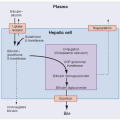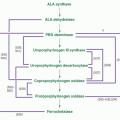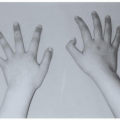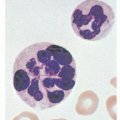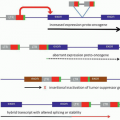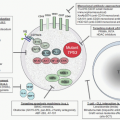Leukocyte Differentials
White cells are analyzed to find the relative percentage of each cell type by a differential leukocyte count. Uniform standards for performing manual differential leukocyte counts on blood smears have been proposed by the CLSI
67 to ensure reproducibility of results between laboratories. It is important to scan the entire blood smear at low power to ensure that all atypical cells and cellular distribution patterns are recognized. In wedge-pushed smears, leukocytes tend to aggregate in the feathered edge and side of the blood smear rather than in the center of the slide. Larger cells (blasts, monocytes) also tend to aggregate at the edges of the blood smear.
68 Use of coverslip preparations and spinner systems tends to minimize this artifact of cell distribution. For wedge-pushed smears, it is recommended that a battlement pattern of smear scanning be used in which one counts fields in one direction, then changes direction and counts an equal number of fields before changing direction again to minimize distributional errors.
67In manual leukocyte counts, three main sources of error are found: distribution of cells on the slide, cell recognition errors, and statistical sampling errors. Poor blood smear preparation and staining are major contributors to cell recognition and cell distribution errors.
69 Statistical errors are the main source of error inherent in manual counts, due to the small sample size in counts of 100 or 200 cells. The CV in manual counts is between 5% and 10% and is also highly dependent on the skill of the technician performing the differential. Accuracy may be improved by increasing the numbers of cells counted, but for practical purposes, most laboratories will do a differential on 100 white cells.
70,71Automated leukocyte differentials markedly decrease the time and cost of performing routine examinations as well as increasing accuracy to a CV of 3% to 5%.
70,71,72 However, automated analysis is incapable of accurately identifying and classifying all types of cells and is particularly insensitive to abnormal or immature cells. Therefore, most analyzers will flag possible abnormal white cell populations, indicating the need for examination by a skilled morphologist for identification.
72 The capacity for performing automated leukocyte differentials is incorporated into hematology analyzers, which identify cells on the basis of cellular size, cell complexity, or staining characteristics as part of the complete blood count, allowing for generation of a five-part differential count that enumerates neutrophils, monocytes, lymphocytes, eosinophils, and basophils.
16Most systems perform cell counts on specimens via continuousflow cytometric analysis of blood samples in which the red cells have been lysed and white cells fixed. The cells are suspended in diluent and passed through an optical flow cell in a continuous stream so that single cells are analyzed for cell size (forward scatter) and complexity (dark-field light scatter) (
Fig. 1.1) or cytochemical characteristics of myeloperoxidase staining (bright-field detector). The data are plotted as a scattergram (
Fig. 1.2), which allows white cells to be divided into a five-part differential (neutrophils, lymphocytes, monocytes, eosinophils, and basophils) and also indicates large unstained or unclassified cells. Lymphocytes are characterized as small (low-scatter) unstained cells. Larger atypical lymphocytes, blasts, or circulating plasma cells fall into the larger cell with a low-complexity channel. Neutrophils have higher complexity and appear as larger cells. Eosinophils appear smaller than neutrophils because they tend to absorb some of their own light scatter. Monocytes have lower levels of complexity and are usually found between neutrophils and lymphocytes. To enumerate basophils, which lack specific staining characteristics and are difficult to enumerate with automated flow-through techniques, a basophil-nuclear lobularity channel may be utilized. For this determination, RBCs and WBCs are differentially lysed, leaving bare leukocyte nuclei, with the exception of basophils, which are resistant to lysis and can then be counted based on relatively large cell size due to the retained cytoplasm. Light scatter data obtained from the leukocyte nuclei may also help identify blasts, which have a lower light scatter than do mature
lymphocyte nuclei. Abnormal cell populations will generate a flag, indicating a need for morphologic review of the peripheral smear.
3 Analysis using this technique examines thousands of cells per sample, increasing statistical accuracy.
16Most of the current hematology analyzers have settings that will allow for evaluation of very hypocellular specimens, such as body fluids. They may be used for analysis of these fluids for enumeration of red cells and white cells, as well as providing a five-part differential count of the white cells. Because of the sampling of higher numbers of cells in these relatively hypocellular specimens, accuracy of cell counts and differential counting is improved.
30,31,73,74 and 75A few instruments, such as the Advia 2120 and the Coulter LH755, also have integrated automated blood smear preparation technology allowing smear preparation directly from the tube upon which the CBC analysis is performed. Thus, the tube is loaded once into a single machine to allow for CBC analysis as well as peripheral blood smear preparation.
16 Many manufacturers also have automated slide makers and stainers, which provide wedge smears from up to 80 slides per hour directly from CBC tubes; however, these are generally free-standing instruments separated from the hematology analyzer. The automated push smear technology helps to provide technical uniformity in blood smear preparation as well as staining. However, there is less flexibility in adjusting stain characteristics. These instruments sample directly from the tube, also minimizing handling of samples by technical staff.
In addition to technology that has the ability to make and stain slides, some automated differential technology via imaging is now available. For instance, Sysmex (CellaVision) has an automated image analyzer that by pattern recognition will capture digital images of 100 to 500 cells in a smear and classify them into morphologic categories to provide a five-part differential. Depending on the model utilized, these technologies have the abilities to perform between 20 and 60 automated digital differentials per hour. The systems have the capacity to store images and are useful in training technologists in the recognition of the specific cell types as well as providing an easily accessible means whereby smears obtained at different times from a single patient may be compared morphologically.
76 These systems have limitations in ability to identify morphologically abnormal cells, so specimens with dysplastic changes, unusual morphologic variants, or significant artifacts may not be evaluable or may provide false data.
77,78,79 Often these systems will place a certain percentage of cells in an unclassifiable area, requiring review by a technologist for definitive identification of the cell type and completion of the differential. As microscopy is automated, there is a uniform scanning of each slide and images are presented on a computer screen, decreasing technician microscope time and scanning pattern variability, and also allowing for the ability to greatly enlarge digitally captured images.
78,80 




